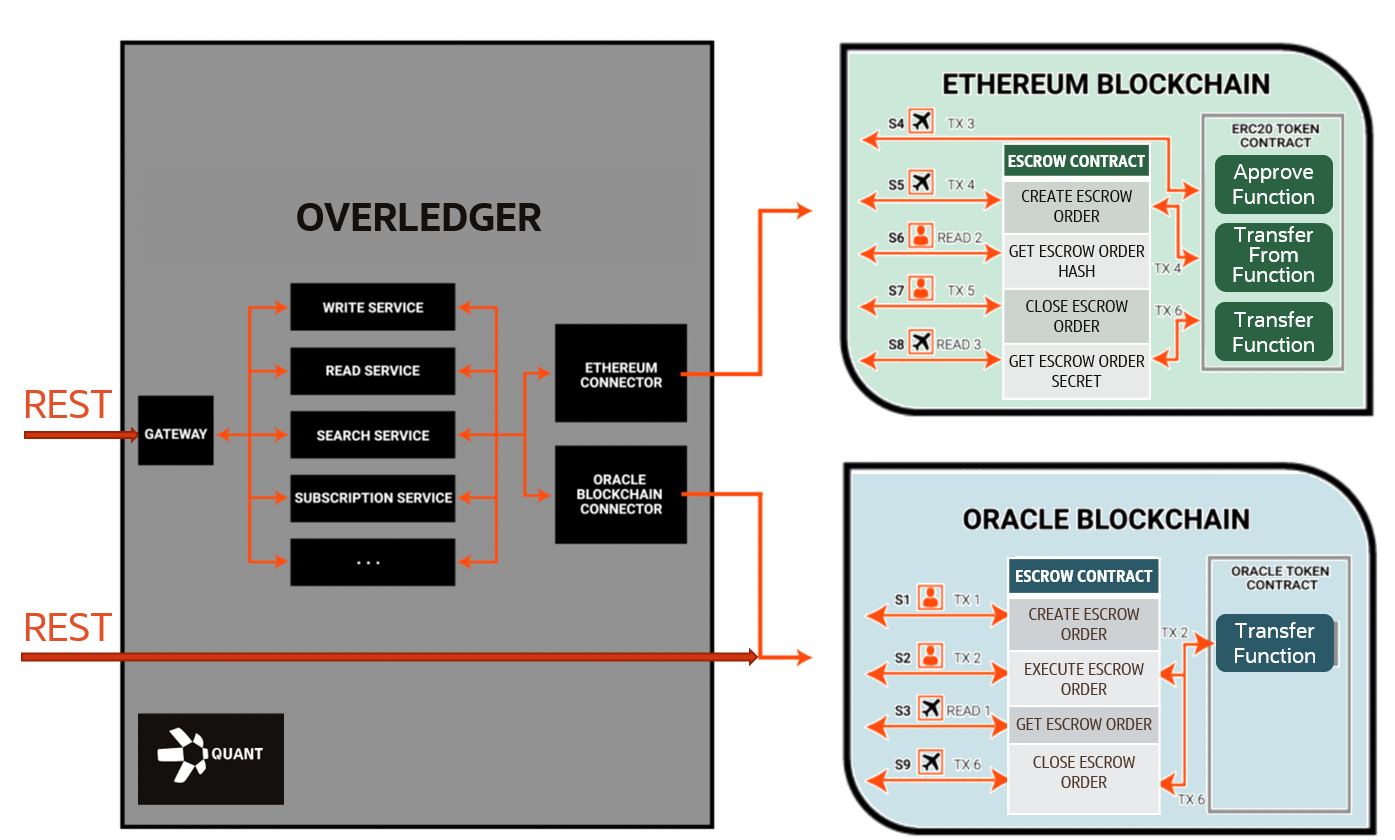Bridge to Cross-Ledger Blockchain Interoperability
Since the last year we have seen growing interest in Blockchain, and it’s plain to see why – the technology is totally re-wiring commerce. It’s driving efficiencies, lowering costs, and opening up new revenue streams. No wonder senior executives are paying attention. According to Deloitte, 77% of financial leaders are worried that they will miss out on an opportunity for competitive advantage if they don’t adopt Blockchain.[1] It’s a big turnaround from a few years ago when Blockchain barely registered on the radar of most companies.
Considering the evolution of distributed ledger technologies, it’s not surprising that blockchain interoperability has become a necessity. More and more companies are using different distributed ledger technologies (DLTs) for different use cases across separate ecosystems, and increasingly, they’re using multiple DLTs across their organisations. Interoperability between blockchain consortiums is picking up speed – as seen in this announcement between Oracle blockchain based Global Shipping Business Network (GSBN) and digital trade finance network Contour based on R3 Corda. Enterprises are also having to pivot to meet their clients’ needs. We’ve come across cases where a client is operating on a different platform to an enterprise, necessitating the latter to integrate into their client’s DLT irrespective of what DLT they’re using.
Three Facets of Blockchain Interoperability
Oracle’s focus on blockchain interoperability started in the early days of Oracle Blockchain Platform release in 2018 with built-in interoperability with other Hyperledger Fabric nodes and continued since with certifications and production customer deployments mixing Oracle blockchain nodes with those from IBM blockchain, Microsoft Azure, Alibaba Cloud Blockchain-as-a-Service, and others based on the work of Hyperledger Fabric Interoperability Workgroup. This enables the first facet of interoperability – a single decentralized ledger to operate in multi-vendor networks across multiple clouds or hybrid deployments with on-premises nodes. Second facet of interoperability is supporting different smart contract frameworks, in addition to the native Hyperledger Fabric smart contracts. Oracle also announced support for running Solidity smart contracts on OBP nodes using Hyperledger Burrow EVM since 20.3.3 release in December 2020. This means that developers can use OBP/Fabric ledger and infrastructure but develop in DAML or Solidity.
Third and perhaps the most challenging facet of interoperability is cross-ledger support when different technologies and protocols are involved. A few open source efforts are focused on this challenge, including Hyperledger Cactus project, and interoperability has recently been added as SG7 working group in ISO TC/307 standards committee on Blockchain and distributed ledger technologies. While these efforts are progressing, none have yet produced enterprise-grade solution ready for production. In parallel, Oracle fintech partner Quant has been working with Oracle and the Oracle Blockchain Platform team to address these challenges with a production-ready solution. The partnership has resulted in Oracle certifying Overledger for interoperability with Oracle Blockchain Platform. For customers looking for production-ready infrastructure to support cross-ledger interoperability between Oracle Blockchain Platform and other ledger technologies, Quant provides an immediately available solution certified in Oracle Cloud Infrastructure.
Designed to deliver universal interoperability between permissioned and permissionless DLTs, Quant’s solution is aimed at:
- Customers that want to be DLT agnostic
- Clients that need to connect different DLTs internally within their organisations
- Businesses that need to move digital assets from one DLT to another – removing the limitations associated with digital assets existing on one DLT
- Organisations that need to orchestrate transactions between different permissioned DLTs
- Customers clients’ that use different DLTs and need those DLTs to interoperate in order to access new markets
Oracle fully understands these issues, which is why the partnership works so well. Quant is now working in a highly collaborative manner with Oracle to rollout solutions on the Oracle Blockchain platform for a variety of sectors. A key sector that we’re engaged in is financial services. There are specific challenges that come with Blockchain interoperability in finance, including identity mapping, privacy, security, data protection and disintermediation – all of which Quant and Oracle are jointly working on.
The modular architecture of Quant’s flagship product – Overledger – is perfect for addressing these challenges. There are three layers to Overledger. There’s the gateway component, where users can send API requests using Quant’s prep-execute model. Supporting this layer is a collection of services that provide core interaction functionality with multiple DLTs. Customers can use these services for a variety of functions – to read data from a Blockchain, write transactions to a Blockchain, and subscribe to Blockchain event information. Lastly, there’s a connector layer for multiple DLTs, including: Hyperledger Fabric and Oracle Blockchain Platform, Ethereum, Hyperledger Besu, R3 Corda, Ripple, and Bitcoin. To add different DLTs, users need specific connectors. Each connector type can be re-used across multiple instances of the same Blockchain technology. For example, the Ethereum connector can be used to connect to the Ethereum Mainnet, an Ethereum testnet, or a private Ethereum network.
Overledger in Action
Recently we showcased the interoperability based on Quant’s Multi-Ledger Tokens solution at an Oracle event hosted by Hyperledger. Oracle has shown its recently introduced Tokenization capability (itself based on Token Taxonomy Framework) in action and demonstrated a number of loyalty points scenarios (starting at 26 minute mark into the recording), including an asset exchange between Oracle blockchain and Ethereum ERC-20 tokens.
In the scenario that was sketched out at the event, a frequent flyer has been issued loyalty points by the airline, represented as fungible tokens (FTs) in their account on Oracle blockchain. The tokens can be redeemed for services on the Oracle Blockchain, for example, a car rental from the airline’s partner company, or swapped into more liquid assets on the Ethereum chain. In this example, the frequent flyer decides to spend some tokens on car hire on the Oracle Blockchain and transfer the remainder over to Ethereum. At the event, Dr Luke Riley, Head of Innovation at Quant, showed how the use case benefits from using Quant’s Overledger solution to implement the asset swap (starting at 44:10 mark in the recording.)
So how does Overledger carry this out? It orchestrates the hash time-locked contract (HTLC) interaction between OBP and Ethereum. The easiest way to describe it is through a series of steps involving the traveller and the airline:
- A smart contract-based escrow is created on the Oracle Blockchain by the traveller and the tokens are transferred into it. This escrow will release the tokens to the airline should a certain secret established by the traveler be sent to it before a particular timeout. After the timeout, if the secret is not received, the traveller can reclaim the funds.
- The airline reads the escrow information so that it can create a corresponding escrow on the Ethereum Blockchain.
- The airline approves tokens of the more liquid asset to be moved into an Ethereum-based escrow and creates the corresponding escrow on Ethereum. This escrow will release the tokens to the traveller when the same secret is sent to it before a similar timeout. It is at this stage of the process that both assets are escrowed inside smart contracts in their corresponding blockchains.
- The traveler reads the escrow that has been created on the Ethereum and checks that it corresponds to the escrow created on the Oracle Blockchain.
- If it corresponds, then the traveler releases the secret which unlocks the funds in the Ethereum escrow and moves them into the traveler’s Ethereum account. The secret is now accessible to the airline.
- The airline reads the secret that has been released by the traveler and sends the secret to Oracle Blockchain to claim the corresponding tokens into the airline account.
All of the interactions to send transactions and query each blockchain are orchestrated via Overledger through Quant connectors for both the Ethereum and Oracle Blockchains. This video explanation can help you to visualize what’s happening to the tokens on both networks.

The example we’ve just outlined involves one particular use case of swapping loyalty tokens between Oracle Blockchain Platform and Ethereum. As well as tokens and digital assets exchanges, Overledger’s ability to transfer data and assets to other DLNs, read Blockchain data using standardised API and data models, write Blockchain transactions using generic prep and execute process, as well as subscribe to Blockchain related events can be used to support endless possibilities. Some examples include:
- Cross DLT Asset Ownership Swap with cancellation and rollbacks
- Dual DLT Logging (e.g., confirming permissioned OBP transactions on public blockchain without disclosing transaction details)
- Complex business process orchestrations (e.g., PO/Invoice matching on OBP and issuing payment on a stablecoin or CBDC, with settlement confirmation recorded on OBP
- Cross-DLT CBDC implementation to support cross-border exchanges when different central banks are using different ledger technologies, or single country CBDC when CB ledger and the ledgers operated by payment providers for their clients are using different frameworks.
The possibilities are endless, which is what makes the technology so exciting.
Build Across Multiple Blockchains with No Coding
Developers can deploy Overledger in one of three ways. The first is through Oracle Cloud Marketplace, for developers or customers who want to use Overledger in their own OCI environment or with Oracle Blockchain Platform. This allows customers to connect to a wide range of blockchains and integrate their own permissioned or private DLTs for enterprise-grade cross-ledger interoperability. To provision Overledger in OCI you need 2 IaaS compute nodes (2 virtual machines with 4 OCPUs, 32GB RAM, 250GB Disk each running Oracle Linux 6.10 to 7.9 or Canonical Ubuntu 18.04 to 20.04 images) plus Kubernetes Clusters (OKE) with Container Registry and Artifact Registry. If you want to add your own Testnet or Mainnet nodes you would need to add an additional compute VM (with 8 OCPUs, 32GB RAM and 250GB Disk) for each blockchain node.
Another option is to use the SaaS version hosted by Quant, which is connected to a select number of public blockchains to build Multi-DLT DApps (mDApps). Developers can easily and quickly get started by creating an account on the Quant developer portal https://developer.quant.network and pass the Know Your Customer (KYC) process to start using the solution – Quant supplies all of the Blockchain nodes for customers to start building interoperable mDApps.
The third option is to deploy on-premises or in a private cloud using a Kubernetes cluster. Contact Quant for details on installing the on-premises version of Overledger.
In all cases, no code is needed to use Overledger, which combined with the Oracle low-code/no-code Blockchain App Builder enables rapid deployment and integration for many enterprise scenarios.
And it’s technology that’s available right now. If you’re using or exploring Oracle Blockchain and you’d like to connect your ledger to other Blockchains, consider how Overledger can help you. Plus, it’s far easier and faster than you might think. Find it on Oracle Cloud Marketplace at this link or talk to us today.

